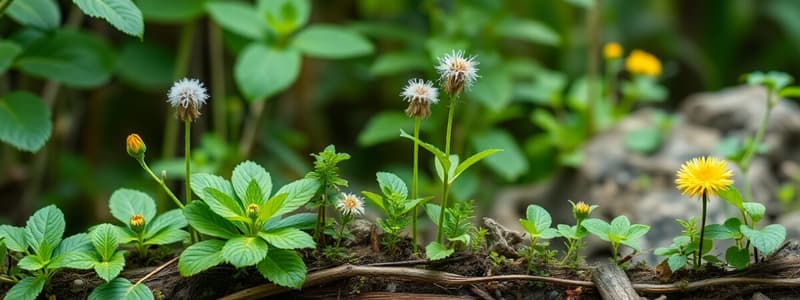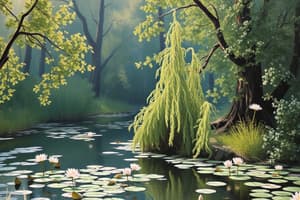Podcast
Questions and Answers
The biosphere describes the living world and an ecosystem is made up of living things (biotic factors) and non-living things (abiotic factors), including factors like water ______.
The biosphere describes the living world and an ecosystem is made up of living things (biotic factors) and non-living things (abiotic factors), including factors like water ______.
salinity
In a population, a group of organisms of one species live in the same place at the same time and this group is known as a ______.
In a population, a group of organisms of one species live in the same place at the same time and this group is known as a ______.
population
Biotic factors include competition within species (intra-specific competition) and between different species (inter-______) for resources.
Biotic factors include competition within species (intra-specific competition) and between different species (inter-______) for resources.
specific
A ______ is made up of populations of different species interacting within a particular environment.
A ______ is made up of populations of different species interacting within a particular environment.
Abiotic factors affecting ecosystems include wind speed, humidity, and ______.
Abiotic factors affecting ecosystems include wind speed, humidity, and ______.
Competition within species for food, water, and breeding partners is classified as ______ competition.
Competition within species for food, water, and breeding partners is classified as ______ competition.
A habitat is a place an organism lives, and the interactions within this habitat can involve ______ relationships such as predation.
A habitat is a place an organism lives, and the interactions within this habitat can involve ______ relationships such as predation.
Abiotic factors include non-living components such as ______ and temperature.
Abiotic factors include non-living components such as ______ and temperature.
Biotic factors are the living components of an ecosystem, which include ______ and animals.
Biotic factors are the living components of an ecosystem, which include ______ and animals.
The distribution of ______ is influenced by both biotic and abiotic factors in their environment.
The distribution of ______ is influenced by both biotic and abiotic factors in their environment.
Population dynamics involves studying the changes in population ______ and sizes over time.
Population dynamics involves studying the changes in population ______ and sizes over time.
Ecosystem interactions can be described as relationships between living organisms and their ______.
Ecosystem interactions can be described as relationships between living organisms and their ______.
Ecology is the study of the interaction between o_________ and their e___________
Ecology is the study of the interaction between o_________ and their e___________
The biosphere is made up of the parts of Earth where l_____ exists.
The biosphere is made up of the parts of Earth where l_____ exists.
An e____________ consists of a community of living organisms together with their non-living physical environment.
An e____________ consists of a community of living organisms together with their non-living physical environment.
Ecosystems can be aquatic (in water) or t__________ (on land).
Ecosystems can be aquatic (in water) or t__________ (on land).
The oceans are a huge e___________ that play a vital role in the Earth's climate.
The oceans are a huge e___________ that play a vital role in the Earth's climate.
MRS C GREN helps remember the 6 life processes: Move, Respire, Sensitivity, Cells, Grow, Reproduce, E__________.
MRS C GREN helps remember the 6 life processes: Move, Respire, Sensitivity, Cells, Grow, Reproduce, E__________.
In ecosystems, the distribution of different s__________ is influenced by both biotic and abiotic factors.
In ecosystems, the distribution of different s__________ is influenced by both biotic and abiotic factors.
Population dynamics studies how populations of organisms change over time, influenced by factors like b__________ and mortality.
Population dynamics studies how populations of organisms change over time, influenced by factors like b__________ and mortality.
Biotic factors include all living organisms, while a_________ factors include non-living elements like water and soil.
Biotic factors include all living organisms, while a_________ factors include non-living elements like water and soil.
Interactions within an ecosystem can be categorized into various types, such as predation, competition, and s__________.
Interactions within an ecosystem can be categorized into various types, such as predation, competition, and s__________.
Flashcards
Abiotic Factor
Abiotic Factor
Non-living part of an ecosystem, like temperature or salinity.
Biotic Factor
Biotic Factor
Living part of an ecosystem, like plants, animals, and bacteria.
Ecosystem
Ecosystem
A community of living organisms interacting with their physical environment.
Community
Community
Signup and view all the flashcards
Population
Population
Signup and view all the flashcards
Interspecific Competition
Interspecific Competition
Signup and view all the flashcards
Intraspecific Competition
Intraspecific Competition
Signup and view all the flashcards
Predation
Predation
Signup and view all the flashcards
Biosphere
Biosphere
Signup and view all the flashcards
Ecology
Ecology
Signup and view all the flashcards
Habitat
Habitat
Signup and view all the flashcards
Aquatic Ecosystem
Aquatic Ecosystem
Signup and view all the flashcards
Terrestrial Ecosystem
Terrestrial Ecosystem
Signup and view all the flashcards
Desert Ecosystem
Desert Ecosystem
Signup and view all the flashcards
Rainforest Ecosystem
Rainforest Ecosystem
Signup and view all the flashcards
Savannah Ecosystem
Savannah Ecosystem
Signup and view all the flashcards
Ecosystem Connections
Ecosystem Connections
Signup and view all the flashcards
Australian Ecosystem
Australian Ecosystem
Signup and view all the flashcards
GRASER
GRASER
Signup and view all the flashcards
MRS C GREN
MRS C GREN
Signup and view all the flashcards
Biosphere Extent
Biosphere Extent
Signup and view all the flashcards
Study Notes
Abiotic Factors
- Examples include salinity, temperature, and light levels.
Biotic Factors
- Examples include populations of mussels, sea stars, and sea anemones.
- These organisms form a community.
Key Vocabulary
- The biosphere is the living world.
- An ecosystem consists of living (biotic) and non-living (abiotic) components.
- A community is made up of different species populations.
- A population is a group of the same species living in the same place at the same time.
Biotic Interactions
- Interspecific competition: Competition for resources between different species.
- Intraspecific competition: Competition for resources within the same species.
- Predation: One organism consuming another.
Abiotic and Biotic Factors
- Abiotic factors: water salinity, wind speed, amount of light, humidity, and air temperature.
- Biotic factors: competitors for food and mating, predators, plants, and bacteria.
Ecology - Levels of Organization
- Biosphere → ecosystem → community → population
- A population is a group of the same species living in the same place at the same time.
- A community is made up of populations of different species.
- A habitat is a place where an organism lives.
Life Processes
- GRASER: Grow, Reproduce, Assimilate, Sensitivity, Excrete, Respire.
- MRS C GREN: Move, Respire, Sensitivity, Made of cells, Grow, Reproduce, Excrete, Nutrition.
Ecosystems
- An ecosystem consists of a community of living organisms and their non-living physical environment.
- Ecosystems can have different sizes: garden pond, tide pool, desert, rainforest, the ocean.
- Ecosystems can be aquatic (in water) or terrestrial (on land).
Examples of Ecosystems
- Desert: Sahara
- Rainforest: Amazon
- African Savannah
- Arctic tundra
- Grassland meadow
- Mediterranean forest
Australian Ecosystems
- Mulga shrub
- Highland heathland
- Wet sclerophyll forest
- Rock platform
- Tropical rainforest
- Billabong
- Desert
- Coral reef
Ecology
- The study of interactions between organisms and their environment.
- The biosphere is the part of Earth where life exists.
- An ecosystem is a community of living organisms and their non-living physical environment.
What is Ecology?
- The word ecology comes from Greek: "οἶκος" (house or environment) and "λογία" (study of).
- The study of interactions between organisms and their environment.
Ecology - Interdisciplinary Field
- Ecology is an interdisciplinary field that includes biology and geography.
- It is the study of the distribution and abundance of organisms, interactions among organisms, interactions between organisms and their environment, and the structure and function of ecosystems.
Our New Unit: Webs of Life
- Ecology is about the relationships between living things and their environment.
Learning Objectives
- Understand key terms: ecology, biosphere, ecosystem, community, population, habitat, abiotic, and biotic.
- Identify examples of different types of ecosystems.
- Identify examples of abiotic factors.
- Understand how abiotic factors influence the type and numbers of species in an area.
Ecosystem Connections
- Living and non-living things are linked together in an ecosystem and impact each other.
The Biosphere
- The biosphere is made up of parts of Earth where life exists.
- It extends from deep-sea trenches to high mountaintops.
- It is about 20 kilometers thick but most life exists between 500 meters below the ocean's surface to 6 kilometers above sea level.
- Covers parts of the lithosphere (rock and soil), hydrosphere (water), and atmosphere (air).
Living vs. Non-Living
- Characteristics of life were studied in the classification topic.
Studying That Suits You
Use AI to generate personalized quizzes and flashcards to suit your learning preferences.
Related Documents
Description
Test your knowledge on the key concepts of abiotic and biotic factors in ecosystems. This quiz covers definitions, examples, and interactions among different organisms and their environment. Understand how these factors contribute to ecological communities.




